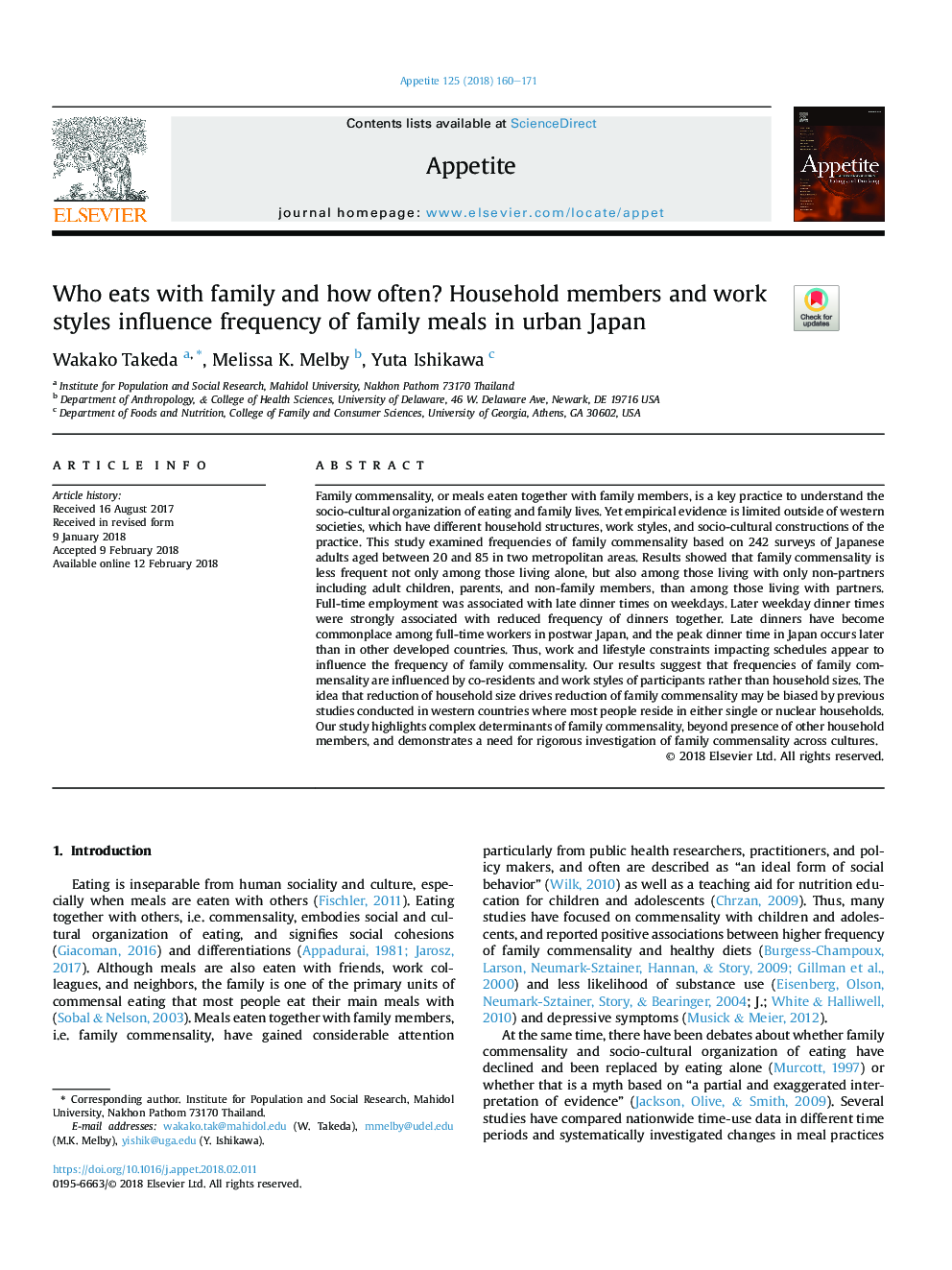| کد مقاله | کد نشریه | سال انتشار | مقاله انگلیسی | نسخه تمام متن |
|---|---|---|---|---|
| 7305747 | 1475355 | 2018 | 12 صفحه PDF | دانلود رایگان |
عنوان انگلیسی مقاله ISI
Who eats with family and how often? Household members and work styles influence frequency of family meals in urban Japan
ترجمه فارسی عنوان
چه کسی خانواده را دوست دارد و چه زمانی؟ اعضای خانواده و سبک های کاری بر میزان غذا خانواده در ژاپن تاثیر می گذارند
دانلود مقاله + سفارش ترجمه
دانلود مقاله ISI انگلیسی
رایگان برای ایرانیان
ترجمه چکیده
هماهنگی خانوادگی، یا غذا خوردن همراه با اعضای خانواده، یک روش کلیدی برای درک سازمان های اجتماعی و فرهنگی خوردن و زندگی خانوادگی است. با این حال شواهد تجربی در خارج از جوامع غربی محدود شده اند که ساختارهای مختلف خانوار، سبک کار و ساختارهای اجتماعی و فرهنگی این عمل را دارند. در این مطالعه، فرکانس های تناسب خانوادگی بر اساس 242 نظرسنجی بالغین ژاپنی بین 20 تا 85 در دو منطقه شهری مورد بررسی قرار گرفت. نتایج نشان داد که همبستگی خانوادگی نه تنها در میان کسانی که به تنهایی زندگی می کنند، بلکه در میان کسانی که تنها با افراد غیر شرعی زندگی می کنند، از جمله کودکان بالغ، والدین و غیر خانوادگی، کمتر از افرادی است که با هم زندگی می کنند. اشتغال کامل تمام وقت در روزهای شام با شام ناهار همراه بود. زمان شام بعد از روزهای هفته به شدت در ارتباط با کاهش شام خوردن همراه بود. شام های بعد از ظهر در میان کارکنان تمام وقت در ژاپن پس از جنگ تبدیل شده اند و زمان شام در ژاپن بعد از دیگر کشورهای توسعه یافته اتفاق می افتد. بنابراین، محدودیت های کار و سبک زندگی تاثیر بر برنامه ها به نظر می رسد بر فراوانی سازگاری خانواده تاثیر می گذارد. نتایج ما نشان می دهد که فرکانس های همبستگی خانوادگی تحت تأثیر ساکنان ساکن و سبک های کار شرکت کنندگان قرار گرفته اند نه اندازه های خانوار. این ایده که کاهش اندازه خانوار باعث کاهش سازگاری خانوادگی می شود، ممکن است مطالعات قبلی در کشورهای غربی که اکثر مردم در خانواده های تک یا هسته ای زندگی می کنند محاصره شوند. در این مطالعه، عوامل مؤثر بر سازگاری خانوادگی، فراتر از حضور سایر اعضای خانواده مشخص می شود و نیاز به تحقیق دقیق در مورد سازگاری خانوادگی در میان فرهنگ ها را نشان می دهد.
موضوعات مرتبط
علوم زیستی و بیوفناوری
علوم کشاورزی و بیولوژیک
دانش تغذیه
چکیده انگلیسی
Family commensality, or meals eaten together with family members, is a key practice to understand the socio-cultural organization of eating and family lives. Yet empirical evidence is limited outside of western societies, which have different household structures, work styles, and socio-cultural constructions of the practice. This study examined frequencies of family commensality based on 242 surveys of Japanese adults aged between 20 and 85 in two metropolitan areas. Results showed that family commensality is less frequent not only among those living alone, but also among those living with only non-partners including adult children, parents, and non-family members, than among those living with partners. Full-time employment was associated with late dinner times on weekdays. Later weekday dinner times were strongly associated with reduced frequency of dinners together. Late dinners have become commonplace among full-time workers in postwar Japan, and the peak dinner time in Japan occurs later than in other developed countries. Thus, work and lifestyle constraints impacting schedules appear to influence the frequency of family commensality. Our results suggest that frequencies of family commensality are influenced by co-residents and work styles of participants rather than household sizes. The idea that reduction of household size drives reduction of family commensality may be biased by previous studies conducted in western countries where most people reside in either single or nuclear households. Our study highlights complex determinants of family commensality, beyond presence of other household members, and demonstrates a need for rigorous investigation of family commensality across cultures.
ناشر
Database: Elsevier - ScienceDirect (ساینس دایرکت)
Journal: Appetite - Volume 125, 1 June 2018, Pages 160-171
Journal: Appetite - Volume 125, 1 June 2018, Pages 160-171
نویسندگان
Wakako Takeda, Melissa K. Melby, Yuta Ishikawa,
